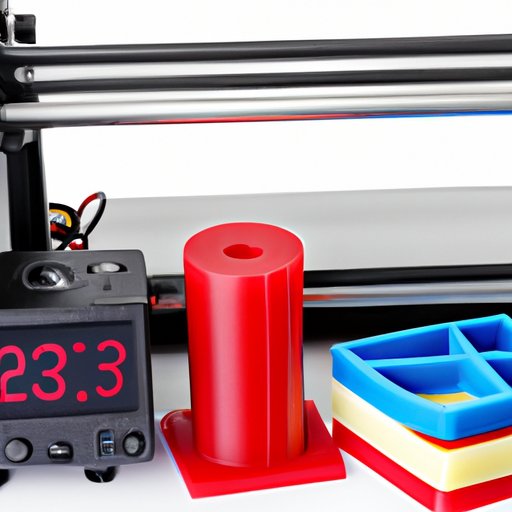Introduction
3D printing has revolutionized the way we create products, from industrial components to consumer goods. It is a form of additive manufacturing that allows for the production of complex shapes and objects with greater accuracy and precision than ever before. But what does 3D printing cost? In this article, we will explore the cost of 3D printing compared to traditional manufacturing, as well as the factors that affect the cost of 3D printing.
Cost Comparison: 3D Printing vs Traditional Manufacturing
When it comes to cost, 3D printing is often more expensive than traditional manufacturing methods such as injection molding. This is because 3D printing requires additional time, labor, and materials to produce a finished product. However, there are some advantages to using 3D printing instead of traditional manufacturing, such as faster lead times, greater design flexibility, and lower setup costs.
To understand the cost differences between 3D printing and traditional manufacturing, let’s take a look at the cost breakdown of each method.
Cost Breakdown of Traditional Manufacturing
Traditional manufacturing processes require a significant upfront investment in tooling, which can cost anywhere from hundreds to thousands of dollars depending on the complexity of the part. Additionally, there are usually high minimum order requirements for traditional manufacturing, meaning that even if you only need a few parts, you may still have to pay for a large batch. Finally, labor and material costs can add up quickly when producing parts in large volumes.

Cost Breakdown of 3D Printing Supplies and Materials
The cost of 3D printing materials varies depending on the type of material used. Commonly used materials include PLA and ABS filaments, resin, and metal alloys. The cost of these materials can range from a few dollars per kilogram to hundreds of dollars per kilogram. Additionally, 3D printers typically require consumable supplies such as build plates, supports, and adhesives.

Exploring the Factors That Affect the Cost of 3D Printing
In addition to the cost of materials, there are several other factors that can affect the total cost of 3D printing. These include the complexity of the design, the volume of parts needed, and the type of printer used.
The complexity of the design is one of the most important factors to consider when estimating the cost of 3D printing. Complex designs require more time and materials to print, resulting in higher costs. Additionally, the volume of parts needed can also have an impact on the total cost, as larger batches tend to be more cost-effective.
Finally, the type of printer used can also affect the cost of 3D printing. Low-end printers are generally more affordable, but they may not be able to produce high-quality parts. Mid-range and high-end printers tend to be more expensive, but they offer greater precision and accuracy.

An Overview of 3D Printer Prices for Different Levels of Quality
Low-end 3D printers are usually the most affordable option, with prices ranging from $200 to $500. These printers are good for basic prototyping, but they may not be able to produce parts with high levels of detail or accuracy.
Mid-range 3D printers are a good choice for those who need more precision and accuracy. Prices for mid-range printers range from $500 to $1,500, depending on features and capabilities. These printers are capable of producing parts with high levels of detail and accuracy.
High-end 3D printers are the most expensive option, with prices ranging from $1,500 to $5,000 or more. These printers offer the highest level of precision and accuracy, and are ideal for producing complex parts with intricate details.

Examining the Pros and Cons of 3D Printing from a Cost Perspective
There are both pros and cons to 3D printing from a cost perspective. On the plus side, 3D printing can reduce setup costs and lead times, allowing for rapid prototyping and testing of new designs. Additionally, 3D printing can produce complex shapes and geometries that would be impossible to achieve with traditional manufacturing methods.
On the downside, 3D printing can be more expensive than traditional manufacturing when producing large volumes of parts. Additionally, 3D printing requires a significant upfront investment in materials, consumables, and equipment, which can add to the overall cost.
What to Consider When Choosing a 3D Printer Based on Budget
When choosing a 3D printer based on budget, it’s important to consider the quality vs price ratio. Low-end printers may be more affordable, but they may not be able to produce parts with high levels of detail or accuracy. On the other hand, high-end printers may be more expensive, but they offer greater precision and accuracy.
It’s also important to consider the level of expertise needed to operate the printer. Some printers require more technical knowledge than others, so it’s important to choose one that matches your skill level. Finally, it’s important to factor in the cost of maintenance and repairs, as 3D printers require regular upkeep to keep them running properly.
Conclusion
In conclusion, 3D printing can be a cost-effective alternative to traditional manufacturing, depending on the complexity of the design, the volume of parts needed, and the type of printer used. Low-end printers are usually the most affordable option, but they may not be able to produce parts with high levels of detail or accuracy. When choosing a 3D printer, it’s important to consider the quality vs price ratio, the level of expertise needed, and the cost of maintenance and repairs.
Overall, 3D printing can be an excellent way to produce high-quality parts quickly and efficiently. With the right combination of materials, design, and printer, 3D printing can be a cost-effective alternative to traditional manufacturing.
(Note: Is this article not meeting your expectations? Do you have knowledge or insights to share? Unlock new opportunities and expand your reach by joining our authors team. Click Registration to join us and share your expertise with our readers.)
